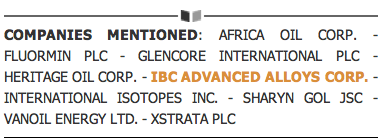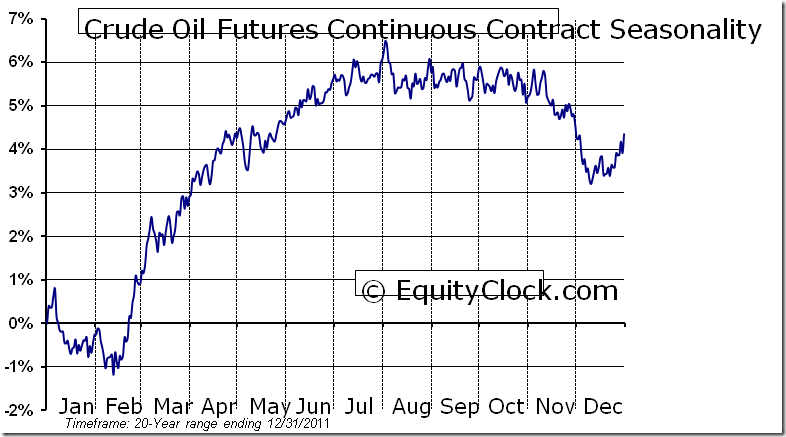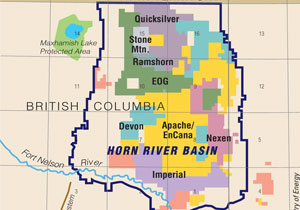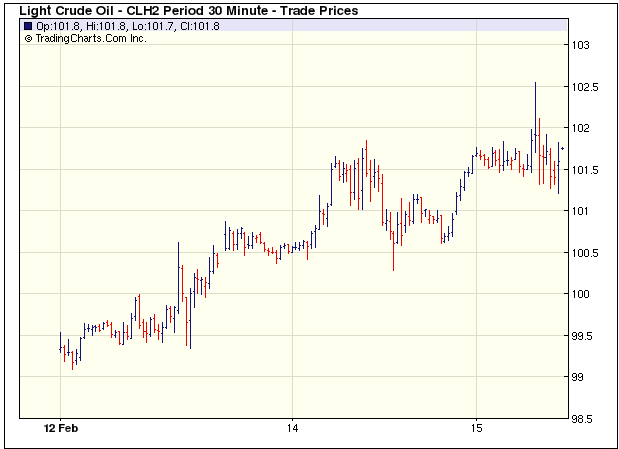Energy & Commodities
Sometimes the most exciting investment opportunities fly under the radar. James Passin of Firebird Management LLC combs the world for emerging opportunities in often overlooked areas. In this exclusive interview with The Critical Metals Report, he discusses companies producing critical materials that could revolutionize defense and aviation technology and make nuclear power safer and more efficient. He also shares some commodities growth stories currently unfolding in Mongolia and East Africa.

The Critical Metals Report: It’s been over two years since you last spoke with us. How have macroeconomic events affected your investment strategy?
James Passin: I am not going to discuss specific investment strategies. But it’s interesting to take a careful look at the current environment, in which there remains a huge amount of fear regarding the solvency of the world financial system. At the same time, there’s clear evidence of growth returning to the USA and certain other regions, although interest rates are near zero and central banks continue to print money. So, I see a situation in which powerful opposing forces at are work, a situation which may continue to manifest itself in violent, short-term fluctuations in asset prices.
I think that the global risk appetite is in a recovery process and that this will gradually lead to more stable capital markets, which should, generally, be positive for equity valuations. But the fear of black swans has kept a lot of cash in the sidelines. There is a danger in remaining out of the market in the current negative interest rate environment.
TCMR: What are you expecting with commodity prices in the next year or so? Will China’s growth continue, or is the country in a bubble?
JP: China has attempted to engineer what the media is calling a “soft landing,” to try to weaken real estate prices and restrain inflation. To some extent, it seems that its policies have been successful. If inflationary pressures in China continue to moderate, then the central bank should have room to loosen credit conditions. This should help to offset economic weakness.
When you look at the strength in copper, the Australian dollar and other leading or coincident indicators of Chinese economic activity, it’s very hard to take a bearish outlook on China. Major Chinese stock indexes have held at support levels and are starting to bounce. So, overall, I expect China’s economy to be somewhat constructive for commodity prices.
TCMR: Do you anticipate any significant potential disruptions to the global economy?
JP: I think we are going to see mergers and acquisitions in the commodity space following the recent high-profile merger of two very large affiliated companies, Glencore International plc (GLEN:LSE) andXstrata PLC (XTA:LSE). Companies that work closely with governments are in a position to implement strategic industrial policy, which may trigger a wave of consolidation in the commodity space and a struggle for control of a limited universe of valuable mineral assets. That environment would create a very positive scenario for the prices of mining companies’ securities in general.
TCMR: Would you say the giant majors and governments of developing nations are competing for assets at the lower end of the food chain?
JP: There’s a lot of evidence to support this view. Indian companies now seem to be on the hunt and there are a lot of buyers for world-class resources. A number of companies that control world-class resource projects seem to have very compelling valuations, following the horrendous equity market in fourth quarter of 2011. I suspect we are going to see a huge number of merger deals, hostile takeovers and various forms of consolidation, reducing the supply of commodity shares.
TCMR: You are invested in critical and strategic metals. What looks attractive to you in those investment areas?
JP: One area we’re focused on is fluorspar, which is an important mineral used in a number of metallurgical processes, such as aluminum production. It’s also the raw material necessary for the production of hydrofluoric acid, which is the precursor to all hydrofluoric chemicals and a number of products containing fluorine or made through the process of fluorination. It’s an obscure commodity, but it is critical to modern life and to the world economy. In fact, it’s so strategic that the EU put it on the list of critical commodities. There has been a lot of government angst about the availability of fluorspar because China controls approximately 50% of world fluorspar production. China was once a fluorspar exporter, but the country is moving more toward exporting value-added chemicals and consuming the raw chemicals itself. That means the rest of the world has to look for non-Chinese sources for fluorspar. There are very few sources of fluorspar from operating mines and not many deposits can be brought into production in the near future either.
TCMR: What are some companies focusing on fluorspar production?
JP: I would suggest taking a look at Fluormin Plc (FLOR:AIM), listed on the AIM Market of the London Stock Exchange. Fluormin owns the producing Witkop fluorspar mine in South Africa as well as 20% of a producing Kenyan fluorspar company. It has other fluorspar exploration projects in various African countries and a joint venture with a fluorspar trading company. Fluormin is a significant producer and trader in the global fluorspar industry. The company is controlled by Firebird and I serve with another colleague on the board of directors.
TCMR: Last time we met, you discussed IBC Advanced Alloys Corp. (IB:TSX.V; AALF:OTCQX). What’s going on with that company?
JP: The stock has been somewhat stagnant, but IBC Advanced Alloys has been growing its revenue. We’re intrigued by the company’s Beralcast business, which involves an aluminum-beryllium composite material with unique characteristics that make it attractive in defense aviation platforms and, potentially, in various commercial aviation applications. It could be a game-changer when you look at the market for beryllium-aluminum composite materials. The company is also exploring for beryllium in Utah, with some promising recent results. I should note that IBC was co-founded by Firebird and Firebird remains a significant shareholder in the company.
TCMR: You cover a wide range of investment arenas both geographically and in terms of commodity type. What looks promising in the energy arena?
JP: Since we started following East African oil in 2003, there have been a number of very large, important discoveries, the most famous of which was Heritage Oil Corp. (HOC:TSX; HOIL:LSE) discovery in Uganda, which proved the existence of world-class oil basins in the Great Rift Valley, precipitating a wave of strategic interest in East Africa. At the same time, evolving geopolitical dynamics are now supportive to East African oil development. For example, South Sudan’s independence created momentum for a new pipeline that can potentially link offshore East African oil fields to export markets, creating a platform for monetization of otherwise stranded oil deposits.
TCMR: What companies in this space are you considering?
JP: I am the Chairman and Interim CEO of Vanoil Energy Ltd. (VEL:TSX.V), which has two blocks in Kenya. Given the amount of interest in Kenya now and the number of deals that we can point to in East Africa, I think it’s worth considering independent companies with acreage in Kenya and the surrounding countries. Vanoil has had some encouraging results from its seismic program and we look forward to advancing further work on our Kenyan properties under the terms of our Production Sharing Contracts. Firebird’s East African holdings include Africa Oil Corp. (AOI:TSX.V), a Lundin company. It has a number of interesting oil exploration projects in East Africa, and the company is currently drilling on two properties, one in Kenya and one in the Puntland Province of Somalia. I’ve been to the Somalian oil concession—it has the potential to prove the existence of Yemen-size oil basins in the Horn of East Africa.
TCMR: You also mentioned Mongolian coal. What’s going on there?
JP: Mongolia has a host of remnants of the sea that vanished when the Indian and Asian subcontinents collided a long time ago. Those remnants formed a vast sedimentary basin that has been transformed into one of the world’s largest undeveloped coal provinces, with both thermal and coking coal. Mongolia’s thermal coal story is quite interesting. China is now the world’s largest importer of thermal coal, while India has very limited supplies of thermal coal. Mongolia will inevitably emerge, in my view, as an important regional thermal coal supplier.
Also, Mongolia is the world’s fastest-growing economy. This is creating a growing need for new electricity generation capacity. The country’s large thermal coal deposits have an important role to play in providing domestic energy. There’s a wave of new interest in Mongolia from strategic and financial investors. We think that the country’s real 2011 gross domestic product (GDP) is probably going to end up 18% higher than the prior year. We believe this GDP is going to keep compounding at a very high rate over the next 10–20 years.
TCMR: How can investors participate in the market in Mongolia? There is a stock exchange there, but not many companies, and liquidity is low. What’s the story there?
JP: We’re very active investors in the Mongolian Stock Exchange (MSE). Certainly the market is not liquid, but there are no restrictions on foreign ownership of shares, and the currency is freely exchangeable. It is very easy to open and fund a brokerage account. The hard part is sourcing shares. The London Stock Exchange (LSE) is now managing the MSE under a three-year contract. We’re quite optimistic about the potential for liquidity on the MSE to increase in the future. Some thermal coal stocks are listed on the MSE, such as Sharyn Gol JSC (SHG:MSE), a coal producer controlled by Firebird. There are other coal companies with assets in Mongolia that are listed on other major exchanges, although we don’t have a particular view on those companies.
TCMR: Let’s switch to nuclear. The U.S. Nuclear Regulatory Commission (NRC) granted some licenses in the last few weeks—the first ones in nearly 35 years. What effect is that going to have on the nuclear fuels and related industries and equipment suppliers?
JP: Although I’ve generally reduced my focus on the nuclear industry following our broad exit from the space during the uranium bubble in 2006, we remain long-term bulls on nuclear power. It is the only economic means of producing electricity without producing vast amounts of carbon. Many government policies will most likely continue to provide at least some economic inducement for nuclear power generation. China will continue to build new nuclear reactors irrespective of the changing political sentiment in some countries following the Fukushima disaster. My focus is mainly in companies that are providing essential services to the nuclear industry and are positioned to benefit from the continued long-term growth in nuclear power generation capacity.
TCMR: What service companies appeal to you?
JP: A U.S. company, International Isotopes Inc. (INIS:OTCBB), is seeking a Nuclear Regulatory Commission (NRC) permit to build the first and only uranium de-conversion and fluorine extraction plant in the world. This plant will take depleted uranium hexafluoride, the toxic waste byproduct of uranium enrichment, and convert it into a stable form of depleted uranium, while extracting the commercially valuable fluorine content. The resulting waste material is far safer and cheaper to store and transport than depleted uranium hexafluoride. If this plant is financed and built and operates successfully, it should significantly reduce the environmental impact of the nuclear fuel cycle.
TCMR: How much commercial value is there in the fluorine? Will the company see substantial profits from producing safer uranium?
JP: I expect the company to have two major revenue streams. The first would be the payment it receives for de-converting uranium hexafluoride, as this provides a direct benefit to the producers of depleted uranium hexafluoride. The second revenue stream will come from extracting the fluorine content and producing fluorine gases and other fluorine products, which it can sell commercially.
TCMR: How large is the fluorine gas market and what kind of sales could International Isotopes expect?
JP: I don’t want to get into financial projections, but the fluorine market is quite large. If you look at all of the fluoride chemical products, especially fluorine gases and products made through the process of fluorination, it is an immense market. I would note that Firebird is a significant shareholder in International Isotopes.
TCMR: We appreciate your time and thoughts today.
JP: My pleasure.
James Passin joined Firebird in 1999. James is a graduate of St. John’s College, where he majored in philosophy and classical literature. James serves on the board of directors of several Mongolian and Canadian companies, including Sharyn Gol JSC, Baganuur JSC, BDSec JSC, National Investment Bank of Mongolia, Vanoil Energy Ltd., Undur Tolgoi Minerals Inc. and Fluormin PLC, a UK fluorspar mining company.
Want to read more exclusive Critical Metals Report articles like this? Sign up for our free e-newsletter, and you’ll learn when new articles have been published. To see a list of recent interviews with industry analysts and commentators and learn more about critical metals companies, visit our Critical Metals Report page.
DISCLOSURE:
1) Zig Lambo of The Critical Metals Report conducted this interview. He personally and/or his family own shares of the following companies mentioned in this interview: None.
2) The following companies mentioned in the interview are sponsors of The Critical Metals Report: IBC Advanced Alloy Corporation. Streetwise Reports does not accept stock in exchange for services.
3) James Passin: I personally and/or my family own shares of the following the following companies, either directly or through indirect ownership through funds and related business entities, mentioned in this interview: Vanoil Energy, Ltd., Fluormin PLC, Sharyn Gol JSC, International Isotopes Inc., IBC Advanced Alloy Corporation and Africa Oil Inc. I personally and/or my family am paid by the following companies mentioned in this interview: none. I was not paid by Streetwise for participating in this story.
Crude oil recently entered into a period of seasonal strength. What are prospects this year?
EquityClock.com notes that West Texas Intermediate (WTI) crude oil prices during the past 20 years have a period of seasonal strength from the middle of February to the end of July. Average gain per period is 7.5 per cent. The seasonal “sweet spot” is from the middle of February to the end of May. Average gain per period was 6.0 per cent.
Strength in WTI crude oil prices during the “sweet spot” is related to rising seasonal demand triggered by a recovery in the economy following the slower winter season. Notable gains are recorded by the transportation, construction and auto sectors. Once again, demand by these sectors is expected to rise this spring, particularly in Canada, United States, Japan, China and India.
Crude oil prices during the “sweet spot” this year are expected to be impacted by several special events that have limited supply. The price of Brent crude oil has jumped more than 14 per cent since mid-December despite a gain of only 8 per cent by WTI crude oil. Brent prices have responded to a decision by European buyers to switch from production from Iran to other sources including North Sea oil. Rising Brent prices slowly, but surely, is filtering back to WTI crude oil prices.
Concern about political instability in the Middle East also is an influence. Iran has threatened to close the Straits of Hormuz if attacked. International concerns about Iran’s nuclear program likely will continue to escalate this spring. On Wednesday, Iran denied a rumor that oil shipments to six European nations had been halted due to recent plans taken by European nations to discontinue purchases of crude oil from Iran by July.
On the charts, the technical picture on WTI crude oil prices is positive and improving. Intermediate trend is up. Support is at $95.44 and resistance is at $103.74. Crude oil recently bounced from near its 200 day moving average at $94.59 and broke above its 50 day moving average at $99.32. Short term momentum indicators are recovering from oversold levels. A break above resistance implies intermediate upside potential to $112.75 per barrel.
Investors can participate in seasonal strength in crude oil directly or indirectly. The direct method is to accumulate futures and Exchange Traded Funds that track the price of crude oil. The best known and most actively traded Exchange Traded Fund is United States Oil Fund LP (USO $39.18). In Canada, Horizons offers several currency-hedged Exchange Traded Funds trading in Canadian Dollars that are directly related to crude oil futures. The indirect way to invest in crude oil is in “oily” stocks.


Don Vialoux is the author of free daily reports on equity markets, sectors,
commodities and Exchange Traded Funds. . Daily reports are
available at http://www.timingthemarket.ca/. He is also a research analyst for
Horizons Investment Management Inc. All of the views expressed herein are his
personal views although they may be reflected in positions or transactions
in the various client portfolios managed by Horizons Investment Management.

For awhile now, North American oil has been all about Alberta and the Bakken.
Natural gas has been all about Haynesville and the Marcellus.
The amount of energy coming out of those locations is undeniable, the media attention and related stock appreciation are warranted.
And they’re undoubtedly helping us lessen our dependence on foreign oil, albeit with much work left to do.
But in the northeast corner of British Columbia, near the border with Alberta, another North American energy story is taking shape. And just as with the others, the first in stand to make the most.
….read more HERE

The move comes days after Iran’s Oil Minister Rostam Qassemi said Tehran could cut off oil exports to “hostile” European nations as tensions rose over suggestions that military strikes are an increasing possibility if sanctions fail to rein in the Islamic Republic’s nuclear ambitions.
Iran argues that the EU oil embargo will not cripple its economy, claiming that the country already has identified new customers to replace the loss in European sales that account for about 18% of Iran’s exports.
Members of Iran’s parliament have been discussing a draft bill, although not finalised, which would cut off the flow to the European Union before the latest EU sanctions on Iran go into effect this summer.
Iran has said it is forced to manufacture nuclear fuel rods, which provide fuel for reactors, on its own since international sanctions ban it from buying them on foreign markets. In January, Iran said it had produced its first such fuel rod.
Iran’s unchecked pursuit of the nuclear programme scuttled negotiations a year ago but Iranian officials last month proposed a return to the talks with the five permanent UN Security Council members plus Germany.
TSX flat amid rising commodities, Greek assurances that it can get bailout

There is a multi-billion dollar water industry forming before investors’ eyes in the oil patch.
It’s a huge opportunity for some great capital gains — but changing regulations, and a very attentive mainstream audience questioning business practises which have been in effect for decades, will will make it choppy water for investors.
“In 2008 there were 25 billion barrels of water handled (by the oil and gas industry) in the US—even at 60 cents a barrel it’s a multibillion dollar business,” says Jonathan Hoopes, President of GreenHunter Energy Inc. (GRH-AMEX). “With the big growth in unconventional since then, it’s likely another 5-6 billion barrels.”
…..read more HERE













